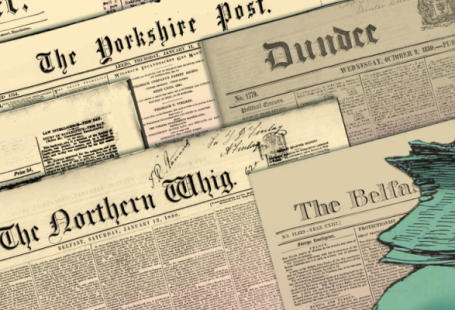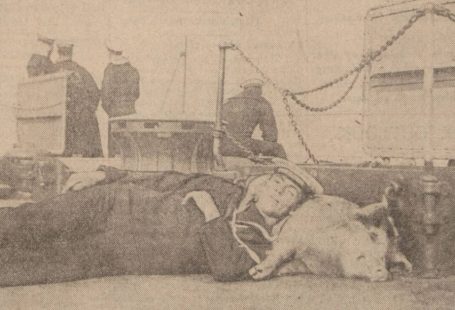Valentine’s Day in its present iteration is inexorably linked to both romantic love and commercialism. It inspires strong feelings, both for and against this day of chocolate boxes and heart-shaped cards. However, the day and its traditions have not been static. In performing a simple search for ‘Valentine’s Day’ on The British Newspaper Archive, you can start to see the ways in which the holiday — and its reception — have changed (and, occasionally, stayed the same) over the years.
An 1845 description in the Monmouthshire Merlin of the holiday’s commercial offerings does not sound wholly out of place in our present-day approach to Valentine’s Day:
The approach of the day is heralded by the appearances in the printsellers’ [sic] shop windows of vast numbers of missives calculated for use on this occasion, each generally consisting of a single sheet of paper, on the first page of which is seen some ridiculous coloured caricature of the male or female figure, with a few burlesque verses below. More rarely the print is of a sentimental kind, such as a view of Hymen’s shrine with a pair undergoing an initiation into wedded happiness before it, while Cupid flutters above, and hearts transfixed with his darts, decorate the corners.
The first recorded example of Valentine’s Day being associated with romantic love came from Geoffrey Chaucer’s 1382 poem Parliament of Foules. Believed to be written in honour of the anniversary of the engagement of King Richard II to Anne of Bohemia, Chaucer’s poem includes the line, ‘For this was on St. Valentine’s Day, when every bride cometh there to choose his mate’. This idea that the romantic customs of Valentine’s Day were related to birds choosing their mates took flight; we can find evidence of this in the papers from the 18th and 19th centuries.
The Hampshire Chronicle on 21 February 1791 printed the following.
There is a rural tradition, that on this day birds choose their mates; whence probably arose the custom of choosing Valentines, which affords an innocent exercise for the fancies of young people in various parts of Europe.

You’ll see from this article that the printed lowercase s looks like a lowercase f. This is called the long, medial, or descending s. By the early 1800s, the use of the long s had all but vanished.
This is, of course, not the only origin story for the holiday. The article continues:
Ghosts were anciently supposed to have the power of walking on the night of this day, whence it became the custom in the followers of the Romish superstition to choose on this day their protecting saints. On this day, in the North of England and in Scotland, it is usual for young persons of both sexes to interchange presents […] [T]he drawing of Valentines is done there with great seriousness, as involving the future fortune of the married state.
In looking at articles on this topic over the span of two hundred years, you start to see the formation of two camps: those who get caught up in the superstitions of the holiday (and subsequently take it very seriously) and those who approach the customs of the day with humor and lightness. On the whole, the trend to take the holiday’s customs seriously was more prevalent in the 1700s, with a waning of such beliefs in the 1800s and into the 1900s.

In commenting on the current state of Valentine’s Day cards in 1845, one author notes that the ‘paltry frivolities’ of the day would have been unknown in Valentine’s Days past, where ‘if letters of any kind were sent, they contained only a courteous profession of attachment from some young man to some young maiden, honied [sic] with a few compliments to her various perfections, and expressive of a hope that his love might meet with return.’

One popular custom was for single men and women to ‘draw lots’ on 13 February to determine who their Valentine would be. In an article from the Monmouthshire Merlin in 1845, we read how this practice began to take on a superstitious quality for some of those participating in it.
In the various jesting ceremonies of the day, there always seems to have been a disposition to believe that the person drawn as a valentine had some considerable likelihood of becoming the associate of the part in wedlock. […] The common people seem to have imagined that an influence was inherent in the day, which rendered in some degree binding the lot or change by which any youth or maid was now led to fix attention on a person of the opposite sex. It was supposed, for instance, that the first unmarried person of the other sex whom one met on St. Valentine’s morning in walking abroad, was a destined wife or husband.
In a 1673 poem included in an article from the Portsmouth Evening News in 1951 on the topic of the Valentine lot, it would ‘suggest that there was as much design as accident int he drawing of the lots’:
Run to Love’s Lottery! Run / maids and rejoice. / When, drawing your chance, / you meet your own choice: / And boast that your luck you / help with design / By praying cross-legged to Old / Bishop Valentine.
By the mid-1700s, the lot was replaced with the freedom to choose one’s Valentine. While this opened the way for new traditions to emerge, the old superstitions did not completely disappear. In The Sketch from 1957 we read the following:
[L]overs sent gifts or verses to their ladies—but never signed, because she must be assumed to know the sender. This left the road open for hoaxes; mock parcels that vanished from the doorstep when pulled by a string; enormous parcels tied to a thread that disappeared, and even hampers from which jumped little boys who had been entrusted with a Valentine’s Message. Ladies spent the night before in superstition and wondering—wedding-cake was put under pillows, or bay leaves pinned to their corners; one recipe even calls for a hard-boiled egg with the yolk extracted and replaced with salt, to be eater, shell and all, before retiring, and that would make you dream of the man who was to be your valentine. Another superstition was that the first man a maid saw on the morning of February 14 would be her husband, so young men with serious intentions came calling early, and young women rose late.

Today, the celebrations surrounding Valentine’s Day are less concerned with superstition and more concerned with the expression of romantic love. Check back in this week as we explore more trends and stories surrounding this holiday!
Register today to uncover more history on holidays past.






